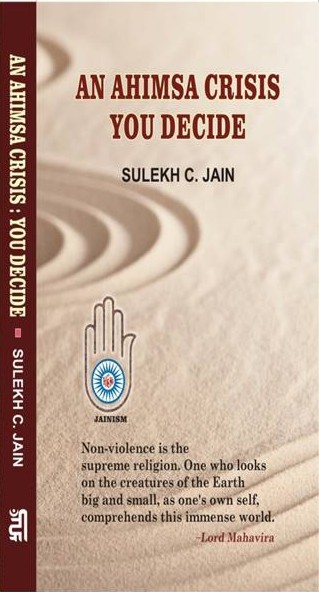Veganism is embraced by some, misunderstood by many, and resisted by others in the Jain community. And yet, the primary tenet of Jainism is ahimsa. Bhagwan Mahavir’s message in the Acharanga Sutra is clear, “all breathing, existing, living, sentient creatures should not be slain, nor treated with violence, nor abused, nor tormented, nor driven away.”
The central philosophy of Jainism and veganism are not only similar, but also complimentary. In pursuit of an ahimsak life, Jains should respect and embrace veganism.
According to the Vegan Society of the UK, “a vegan is someone who tries to live without exploiting animals, for the benefit of animals, people and the planet. Vegans eat a plant- based diet, with nothing coming from animals—no meat, milk, eggs or honey, for example. A vegan lifestyle also avoids leather, wool, silk, pearl and other animal products.”
Donald Watson, of the Vegan Society, was the first to combine the beginning and end of the word “vegetarian,” symbolizing that veganism is the logical conclusion of the vegetarian journey to avoid animal suffering and death; he coined the word “vegan” in 1944.
Vegans recognize that as an ethical matter, milk, even “organic” or “humane” milk is inherently a product of violence. Some people believe that milk production in India is still humane but the truth is otherwise. If you are not sure about this, use the Internet to conduct independent research, visit a dairy farm, or read about it in Pravin K. Shah’s My Visit to a Dairy Farm, which is archived in the Jain collection at Harvard University and can be found online at:
http://www.fas.harvard.edu/~pluralsm/affiliates/jainism/ahimsa/dairy.htm
A few years ago, I along with quite a few Jains (from different parts of USA and Canada) visited a dairy farm in the State of Vermont (USA) and saw with our own eyes the cruelty and suffering that we been reading so often. This is true.
To review, the meat and milk industries are inextricably linked; they are two sides of the same violent coin. The cost of beef is subsidized by the sale of milk and leather. All livestock in a dairy farm are predestined for the slaughterhouse: newborn male calves for veal within six months of birth and the remaining female cows when, by the age of five years, milk production starts to decrease. The natural life span of a cow is more than twenty years.
Dairy cows are often fed ground up fish and bone, routinely injected with hormones, repeatedly impregnated for continuous milk production and separated from their calves very shortly after birth. There can be no doubt that the production of dairy, however “humane” we may try to make it, will always involve violence to five-sensed creatures (Panchandriyas). Moreover, milk production is a tremendous burden on the environment; it takes a great deal of grain, water and energy to produce dairy products, and there are many harmful consequences of waste and pollution that result.
Some Jains point to scriptures that indicate that Tirthankaras consumed some milk products. It must be remembered, however, at that time there was no intensive or “factory” farming. Moreover, at that time, there were no mass distribution systems or storage systems for grains and other agricultural products. So taking small amounts of locally produced fresh dairy products may have represented the minimum amount of himsa necessary given conditions then. Cows were treated as revered members of the family and oxen were used in farming. The animals were not killed even when they stopped producing milk or stopped working in the fields. We cannot be certain of all the conditions of those days but we know for sure that things are very different now.
According to Jain theory, milk and milk products are considered Vigayee or Maha-Vigavee and are prohibited during Ayambil. Therefore, eliminating (or minimizing) the use of milk or milk products is not such a strange or alien concept to Jains.
There are now convenient and tasty substitutes for milk, ice cream, yogurt, butter and ghee, as well as alternatives to things like leather, silk, wool, and pearls. Also, we must keep in mind the health benefits of veganism; the American Dietetic Association has a position paper that explains how vegan diets help manage and reduce chronic degenerative disease like heart disease, cancer, stroke, diabetes, and obesity. Although vegan ideals are becoming more common among Jain youth, the older, more tradition-minded generation resists it.
We have to examine the himsa footprints in everything we consume. The theories behind veganism are closest to Jain ideals and a step ahead of just being vegetarian. Veganism is a natural expression and expansion of our highest ideals of ahimsa. There is no other life style that comes closer to the Jain philosophy of non-violence as ethical veganism does. When we understand the true basis of their belief as Jiv Daya, we must develop respect for their commitment and embrace vegans as our soul mates.
An Ahimsa Crisis: You Decide: Jainism And Veganism: Ahimsa In The Modern World
Author:
 Dr. Sulekh Chand Jain
Dr. Sulekh Chand Jain
 Dr. Sulekh Chand Jain
Dr. Sulekh Chand Jain
Published: 29.07.2016
Updated: 29.07.2016
Updated: 29.07.2016
Sources
 Title: An Ahimsa Crisis You Decide
Title: An Ahimsa Crisis You DecideAuthor: Sulekh C. Jain
Edition: 2016, 1st edition
Publisher: Prakrit Bharati Academy, Jaipur, India
Page glossary
Some texts contain footnotes and glossary entries. To distinguish between them, the links have different colors.
Page statistics
This page has been viewed 828 times.